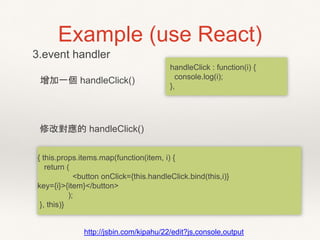透過範例學習React (react tutorial 2)
- 1. Justin @ 2015 Aug 透過範例學習React React tutorial 2
- 2. React 學習目標 1. 元件之間的溝通 (parent vs children ) 2. Props vs State 目前我把他解讀是.... Props 靜態 (初使化設定) State 動態 (可被改變 ex:setState()…) 3. 透過 refs 取得dom 裡面的值
- 3. Example 1. props example - “Hello World” 2. state example - “Hello xxx” http://jsbin.com/kodalu/1/edit?js,output
- 4. http://jsbin.com/kajonu/edit?js,output React 元件之間的溝通 parent v.s children
- 6. Example (use React) react final code : http://jsbin.com/kipahu/31/edit?js,output Step: 1. Render component 2. init state 3. Event Handler
- 7. Example (use React) 1.Render component var App = React.createClass({ render : function() { return ( <div classNnme="wrap"> <h2>你選的是?<span classNnme="result"></span></h2> <button classNnme="btn">Banana</button> <button classNnme="btn">Apple</button> <button classNnme="btn">Orange</button> </div> ) } }); React.render(<App items={["Banana","Apple","Orange"]}/>, document.body); http://jsbin.com/kipahu/28/edit?js,output
- 8. Map 是尛? map 可以拿來操作Array, 並回傳一個新的array MDN的文件 https://developer.mozilla.org/en- US/docs/Web/JavaScript/Reference/Global_Objects/Array/ map
- 9. Map 是尛?
- 10. Map 是尛?
- 11. Example (use React) 1.render http://jsbin.com/kipahu/27/edit?js,output 修改對應render() 把<button> 拿掉 用map function 來處理 render { this.props.items.map(function(){}, this); } 繼續完成 map { this.props.items.map(function(item){ return ( <button>{item}</button> ) }, this) }
- 12. Example (use React) 3.event handler { this.props.items.map(function(item, i) { return ( <button onClick={this.handleClick.bind(this,i)} key={i}>{item}</button> ); }, this)} http://jsbin.com/kipahu/22/edit?js,console,output 增加一個 handleClick() handleClick : function(i) { console.log(i); }, 修改對應的 handleClick()
- 13. Example (use React) http://jsbin.com/kipahu/29/edit?js,output handleClick : function(i) { this.setState({ result: this.props.items[i] }); } 4. click後修改 handleClick()
- 14. Example (use React) render : function() { return ( <div className="wrap"> <h2>你選的是?<span className="result">{this.state.result}</span></h2> { this.props.items.map(function(item, i) { var cssStyle = (item === this.state.result ? "btn is-active":"btn"); return ( <button className={cssStyle} onClick={this.handleClick.bind(this,i)} key={i}>{item}</button> ); }, this)} </div> ) } 5. 修改render() done !! react final code : http://jsbin.com/kipahu/31/edit?js,output
- 16. React 學習目標 1. 使用refs 取得 dom value React 支援一個非常特別的屬性,你可以把它附加到任何在 render() 裡面的元件上(就是標簽 tag 上)。這個特殊的屬性可 以讓你存取到對應的『背後的實際物件』,它保證可以在任 何時間點存取到當下的物件。
- 17. Example http://jsbin.com/jijavi/1/edit?js,output 1. 使用refs和getDOMNode() 取得 dom value
- 19. var App = React.createClass({ render: function() { return ( <div> <input type="range" min="0" max="255" /> </div> ) } }) React.render(<App/>, document.body); 1. render() 來呈現一組slider http://jsbin.com/losiji/9/edit?js,output Example (use React)
- 20. var App = React.createClass({ getInitialState: function() { return {value: 128} }, render: function() { return ( <div> <input type="range" min="0" max="255"/> <label>{this.state.value}</label> </div> ) } }); 2. init state Example (use React)
- 21. update : function() { console.log(this.refs.ipt.getDOMNode().value) }, 3. update event handler http://jsbin.com/losiji/7/edit?js,output render: function() { return ( <div> <input ref="ipt" type="range" min="0" max=“255" onChange={this.update}/> <label>{this.state.value}</label> </div> ) } Example (use React)
- 22. update : function() { this.setState({ value: this.refs.ipt.getDOMNode().value}) }, 4. update and setState http://jsbin.com/losiji/8/edit?js,output Example (use React)
- 23. <div> <input ref="ipt" type="range" min="0" max="255" onChange={this.update}/> <label>{this.state.red}</label> <input ref="ipt" type="range" min="0" max="255" onChange={this.update}/> <label>{this.state.green}</label> <input ref="ipt" type="range" min="0" max="255" onChange={this.update}/> <label>{this.state.blue}</label> </div> 5. 產生三組input type=“range” http://jsbin.com/losiji/10/edit?js,output getInitialState: function() { return { red : 128, green: 128,blue : 128 } } Example (use React)
- 24. var Slider = React.createClass({ render : function() { return ( <div> <input ref="ipt" type="range" min="0" max="255" onChange={this.props.update}/> </div> ); } }); 6. 建立新的元件 <Slider /> http://jsbin.com/losiji/13/edit?js,output <Slider ref="red" update={this.update}/> <label>{this.state.red}</label> … render() 裡面的input也要對應修改成: Example (use React)
- 25. update : function() { this.setState({ red : this.refs.red.refs.ipt.getDOMNode().value, green: this.refs.green.refs.ipt.getDOMNode().value, blue : this.refs.blue.refs.ipt.getDOMNode().value }); }, 7. 修改 update() http://jsbin.com/losiji/14/edit?js,output 現在可以玩一玩slider 控制器了 但還沒完,我們要有地方把顏色輸出 Example (use React)
- 26. var convertColor = function(rgb) { return "#" + ("0" + parseInt(rgb[0],10).toString(16)).slice(-2) + ("0" + parseInt(rgb[1],10).toString(16)).slice(-2) + ("0" + parseInt(rgb[2],10).toString(16)).slice(-2); } 8. 增加一個 function 處理RGB 轉 16進位 Example (use React)
- 27. divStyle : function() { return( {"background":convertColor([this.state.red, this.state.green, this.state.blue])} ) } 9. 增加一個 function 把處理完的色碼回傳到view http://jsbin.com/losiji/14/edit?js,output Example (use React)
- 28. render: function() { return ( <div> <div className="show-color" style={this.divStyle()}></div><br/> … </div> ); } 10.修改 render() 並新增一個 div 來顯示色塊! done! http://jsbin.com/losiji/15/edit?js,output .show-color{ width : 300px; height : 100px; border:1px solid #ccc; } 幫div 設定基本的樣式 Example (use React)
- 29. var Slider = React.createClass({ render : function() { return ( <div> <input ref="ipt" type="range" min="0" max="255" > </div> //不能在這邊再加入一個 <div> ); } }); 1. React 需要一個根節點, 也只能有一個 React 地雷







![Example (use React)
1.Render component
var App = React.createClass({
render : function() {
return (
<div classNnme="wrap">
<h2>你選的是?<span classNnme="result"></span></h2>
<button classNnme="btn">Banana</button>
<button classNnme="btn">Apple</button>
<button classNnme="btn">Orange</button>
</div> )
}
});
React.render(<App items={["Banana","Apple","Orange"]}/>,
document.body);
http://jsbin.com/kipahu/28/edit?js,output](https://image.slidesharecdn.com/reactreacttutorial2-150902072901-lva1-app6891/85/React-react-tutorial-2-7-320.jpg)





![Example (use React)
http://jsbin.com/kipahu/29/edit?js,output
handleClick : function(i) {
this.setState({
result: this.props.items[i]
});
}
4. click後修改 handleClick()](https://image.slidesharecdn.com/reactreacttutorial2-150902072901-lva1-app6891/85/React-react-tutorial-2-13-320.jpg)












![var convertColor = function(rgb) {
return "#" +
("0" + parseInt(rgb[0],10).toString(16)).slice(-2) +
("0" + parseInt(rgb[1],10).toString(16)).slice(-2) +
("0" + parseInt(rgb[2],10).toString(16)).slice(-2);
}
8. 增加一個 function 處理RGB 轉 16進位
Example (use React)](https://image.slidesharecdn.com/reactreacttutorial2-150902072901-lva1-app6891/85/React-react-tutorial-2-26-320.jpg)
![divStyle : function() {
return(
{"background":convertColor([this.state.red, this.state.green, this.state.blue])}
)
}
9. 增加一個 function 把處理完的色碼回傳到view
http://jsbin.com/losiji/14/edit?js,output
Example (use React)](https://image.slidesharecdn.com/reactreacttutorial2-150902072901-lva1-app6891/85/React-react-tutorial-2-27-320.jpg)




















